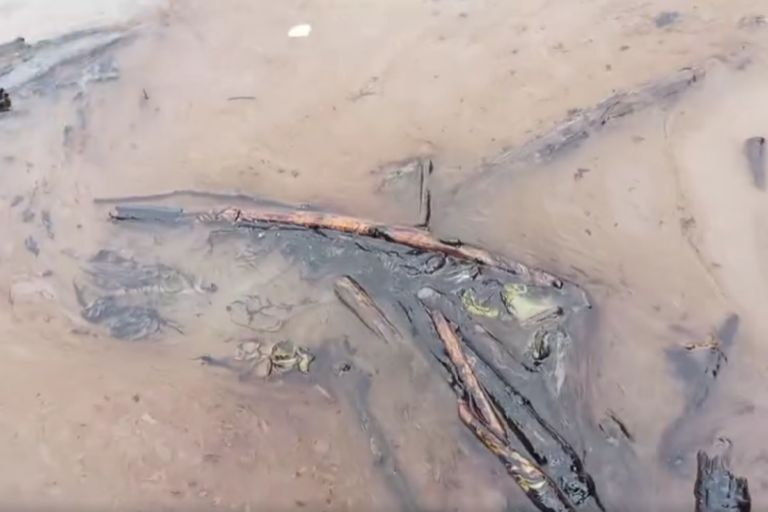- On March 5, a collision between two oil barges in the Peruvian Amazon led to an oil spill in the Puinahua River, near Pacaya-Samiria National Reserve, a protected region of rainforest.
- Since the spill, local Indigenous communities, who almost exclusively depend on the river for their livelihoods, have been unable to collect water or fish due to fear of contamination.
- The impacted communities are awaiting compensation for their losses, yet face a deadlock as environmental assessments, which could take weeks, must be conducted first before payments are made.
- The ecological, economic and social impacts of the oil spill have not yet been published; For decades, the Peruvian Amazon has been subjected to hundreds of oil spills and leaks, which experts say have wreaked havoc on the basin.
As dawn began to break in the Peruvian Amazon on March 5, an oil slick spread across the Puinahua River in the district of the same name, engulfing clumps of palms and reeds in a thick, black layer as it streamed down the current. The sight of the spill prompted a desperate rush among the riverside Manco Cápac community to prevent the oil from contaminating the river they depended on for their survival.
“I woke up to chaos,” Kara Fikrig, a biologist with Cornell University who studies dengue in the region, told Mongabay. “People were out on their canoes, using their bare hands, using buckets to scoop up the oil. “They had buckets full of this pure-looking crude petroleum oil.”
The oil spill happened near Pacaya-Samiria National Reserve, a protected area of rainforest, 2 kilometers (1.2 miles) from the PetroTal SA oil base in Lot 95 in Brittany. Two bars belonging to Trans Fluvial Rey EIRL (known in the area as Transportes Henry or Grupo Henry) had collided while docking, causing the tanker carrying crude oil to leak.
The accident happened at around 5 am; By 10 in the morning, there was a “high concentration” of oil streaming down the river, a tributary of the Amazon, an hour away from the spill site, Fikrig said. “It makes me believe it was quite a bit of that tanker had spilled.”
A representative for Trans Fluvial Rey, Carmen Raquel Nuñez Rengifo, told Mongabay that Grupo Henry was taking responsibility for the incident, including providing compensation to impacted communities. To date, it’s unclear what that final sum is.
The Manco Cápac community, made up of 582 Indigenous Kukama Kukamiria people, is one of the worst impacted by the spill, although several other communities have also been affected. These communities depend almost entirely on the river for their livelihoods, including for food and for selling fish for income. The river is also essential for fish supplies to other nearby regions: up to 80% of the fish that feeds Iquitos, the largest city in the Peruvian Amazon, comes from the river in this district, Fikrig said.
The community fears the water, fish and crops are contaminated from oil. It’s preventing them from eating anything from the river, which means they’ve been unable to catch and sell fish.
“Right now, [the community] “they cannot do their daily activities that they were previously doing to support their family,” Jenner Canayo, the communal president in Manco Cápac, told Mongabay. “We are not doing our fishing activities. We are not consuming the fish.
“It is worrying for us because right now we have children in school, in higher education, and there is no way to make a living to be able to cover the needs of our students,” he added.
The Indigenous Association for the Development and Conservation of the Lower Puinahua (AIDECOBAP) called the incident an “environmental crime with incalculable consequences,” in a statement published March 6 on its Facebook page. It identified nine groups, including Manco Cápac, that had been affected, and reiterated that their main source of food comes from the river.
So far, neither Trans Fluvial Rey nor government authorities have released any information about how much crude oil was spilled or about the ecological, social and economic impacts. According to the minutes of a March 23 meeting between state authorities, local oil and gas companies and the local population, which PetroTal shared with Mongabay, representatives for Trans Fluvial Rey said they have “specialists who are evaluating the impact of people, flora, fauna ,fish, [and] fishing activities, to identify the extent of the impact on all sectors of the population.” They also requested “a little patience to complete the necessary studies to gather all the information and deal with the issue of compensation.” Assessments are being conducted in both the lower and upper stretches of the Puinahua, although these have not been completed yet.
A government statement released March 5 said the country’s environmental regulator, OEFA, was monitoring the situation, but no results have yet been published. OEFA did not reply to Mongabay’s request for information.
Seeking compensation
Local communities have reached a deadlock in negotiating damage compensation with the oil transportation company and the Peruvian bureaucracy.
In the immediate aftermath of the spill, thousands of community members had meetings with Grupo Henry representatives, including Manco Cápac members who reportedly sought 3,000 soles ($815) per person per month until the oil effects were contained.
Trans Fluvial Rey later proposed it could provide an emergency one-off payment of 1,000 soles ($272) through its insurance company to each person over 18 in the district by April 20. This still hasn’t been paid.

“Everyone was very upset,” Fikrig said of the decision of the one-time payment per family. Locals and experts say 1,000 soles isn’t enough, especially as the communities haven’t been able to fish since the spill.
Nuñez Rengifo said Trans Fluvial Rey must follow specific procedures to get the insurance company, based in the UK, to pay, which is why there are delays in paying compensation. “We can’t make decisions because they’re still doing the studies,” she said. “If we don’t have a valid document to justify it, [the insurance company] won’t give us a penny to pay, to disburse and care for that population.”
One of the setbacks lies with Peru’s red tape, she said. The insurance company needs specific documents from the national population registry, or RENIEC, to identify permanent residents in the affected community. “There are people who, although they register their address in Puinahua in RENIEC, they do not live in the district,” according to the minutes from the March 23 meeting.
But this is taking time to obtain, Nuñez Rengifo said. “The Peruvian bureaucracy is out of the control of the company,” she said, adding she has contacted authorities to speed up the process, but without any luck.
Both PetroTal and Trans Fluvial Rey have provided water and food to the communities. PetroTal told Mongabay in a statement that it “delivered, in solidarity, more than 46 tons of food and more than 50,000 liters [13,200 gallons] of water.”
Canayo confirmed his community has received donations of food and water, but said “it is not enough” for all the families. “We received donations of water, such as these 20-liter [5-gallon] bottles, but that is not enough, because water is an element that is used from minute to minute.
“The population is suffering right now,” he added.
The nonprofit Environmental Defense Law Center (EDLC) is providing legal advice to the communities of Manco Cápac, San Pedro I and San Pedro II, with the aim of negotiating better compensation for the communities. “These communities have been greatly impacted by the spill as their main activity and important source of food is fishing, which they have been prevented from doing since the spill,” Margarida Ravara, staff attorney at EDLC, told Mongabay. “At the moment, the situation is very difficult for these communities.”
Ravara said the EDLC faced difficulties in gathering information about the case, which she attributed both to the remote location of the communities and also “to the fact that the municipality is not being very diligent when it comes to providing information.”
Mongabay contacted several government authorities about the oil spill, including the Ministry of Environment, the mayor of Puinahua, and the Ministry of Energy and Mines, but was unable to get status updates about the spill.

The initial cleanup was first conducted by Lamor, a company specialized in oil spills, on the day of the incident. Lamor sent statements to Mongabay that showed it had carried out cleanup work for two weeks until it was notified by Trans Fluvial Rey and Novum Energy Trading Corp., the buyer of the spilled oil, that a different entity would take over. According to the minutes from the meeting on March 23, Clean Pacific was contracted to summarize the cleanup, but it’s unclear how much pollution remains.
Long history of oil spills
Peru has seen repeated oil spills over the past two decades, including in its rainforest. Between 1997 and 2021, there were 566 oil spills in the Peruvian Amazon, 404 along its coast, and five in the highlands, according to a report >by Oxfam and Peruvian human rights coalition CNDDHH.
Puinahua district has also seen several clashes between local communities and the oil industry. In 2022, Mongabay reported on the environmental and noise pollution complaints of the Villa Gran Tierra community from PetroTal’s operations, including reported contamination from Lot 95 that community members blamed for failed crop harvests and outbreaks of stomach ailments.
The constant spills and leaks have led to intense anti-oil protests in the country’s Amazonian region, some of which have turned violent and even deadly. In August 2020, three members of the Villa Gran Tierra were shot dead by police during a demonstration outside PetroTal’s facility.
Nuñez Rengifo protecting said the oil industry in the region is critical for Peru’s economy and that the government needs to be more involved in helping communities that the authorities have otherwise “forgotten.”
For many communities in the region, the best solution is to simply not have oil activity in the region at all. In a statement published March 28, AIDECOBAP said, “Now we are organizing to expel [PetroTal] from our territories for all the damage it is causing in all the AIDECOBAP base communities.”
Banner image: Bunches of oil-covered vegetation were collected from the river after the spill on March 5 contaminated a section of the river in the Puinahua district near Pacaya-Samiria National Reserve. Image © Kara Fikrig.
FEEDBACK: Use this form to send a message to the author of this post. If you want to post a public comment, you can do that at the bottom of the page.
Amazon Mining, Corporate Responsibility, Corporations, Indigenous Communities, Indigenous Groups, Indigenous Peoples, Mining, Oil Spills, Rivers, Water Pollution
Latin America, Peru, South America









